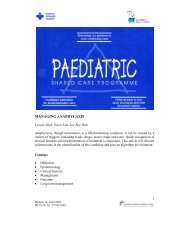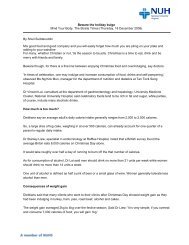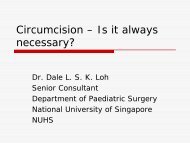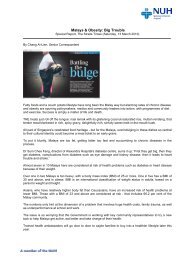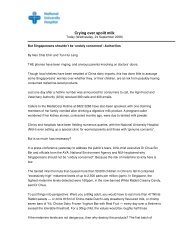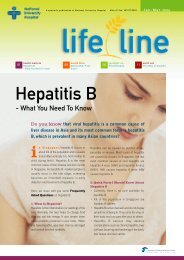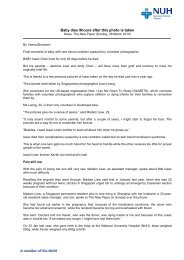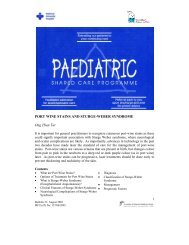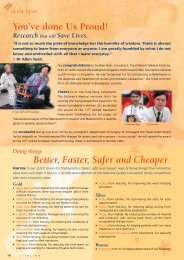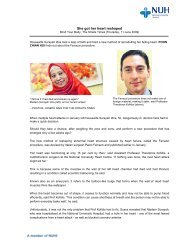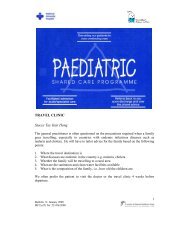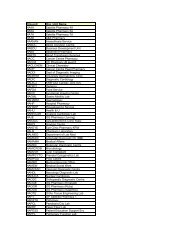Dual Organ Transplant – Double the Bliss - NUH
Dual Organ Transplant – Double the Bliss - NUH
Dual Organ Transplant – Double the Bliss - NUH
Create successful ePaper yourself
Turn your PDF publications into a flip-book with our unique Google optimized e-Paper software.
cover story<br />
02<br />
On 3 November 2010 at 4am,<br />
which was about <strong>the</strong> same<br />
time <strong>the</strong> alarm went off to wake<br />
Weihao for his kidney dialysis, he received<br />
a call that would change <strong>the</strong> course of his<br />
life. His long wait was over - a suitable liver<br />
and kidney had been found.<br />
Weihao suffered from primary<br />
hyperoxaluria <strong>–</strong> a rare genetic disorder<br />
which led him to form kidney stones at <strong>the</strong><br />
tender age of five.<br />
Sometime in 2009, Weihao’s fa<strong>the</strong>r noticed<br />
that something was not right with his only<br />
son as he was losing weight. Weihao<br />
also got tired very easily. His kidney was<br />
starting to fail.<br />
Weihao started dialysis - which took him<br />
around 10 hours everyday - when his<br />
kidney failure became more acute.<br />
‘His weight dropped drastically from<br />
68kg to 58kg in a matter of weeks. He<br />
was about 50kg when he went in for <strong>the</strong><br />
operation,’ said his mo<strong>the</strong>r.<br />
On that fateful night, Professor K<br />
Prabhakaran, Director, Paediatric <strong>Organ</strong><br />
<strong>Transplant</strong> Programme at <strong>NUH</strong> was<br />
awoken from his sleep by a call at 2am,<br />
informing him that <strong>the</strong>re was a suitable<br />
liver for Weihao. At <strong>the</strong> same time,<br />
Weihao’s primary physician Prof Yap<br />
Hui Kim contacted him to discuss <strong>the</strong><br />
possibility of a simultaneous liver and<br />
kidney transplant.<br />
When both organs were found to be<br />
suitable, <strong>the</strong>y called to inform <strong>the</strong> family<br />
at 4am. Weihao was admitted at 7am to<br />
prepare for <strong>the</strong> surgery.<br />
The multi-disciplinary team led by<br />
Professor Prabhakaran started with <strong>the</strong><br />
liver transplant operation which took<br />
eight hours. Professor Prabhakaran<br />
and Dr Tiong Ho Yee, Consultant,<br />
Department of Urology, <strong>NUH</strong> <strong>the</strong>n<br />
moved on to <strong>the</strong> kidney transplant<br />
which took ano<strong>the</strong>r three hours.<br />
Weihao received a new kidney and<br />
liver in slightly over 24 hours.<br />
The surgery scored a first in <strong>the</strong><br />
medical history in Singapore, making<br />
it to a selected list of success stories in <strong>the</strong><br />
world. A 2006 American report stated that<br />
to date, only 1,032 combined liver-kidney<br />
transplants (inclusive of adults) had been<br />
performed worldwide.<br />
Now Weihao is able to do<br />
<strong>the</strong> one thing he has always<br />
dreamed of - to travel<br />
<strong>the</strong> world.<br />
Mdm Lim Kim Hiok,<br />
Weihao’s mo<strong>the</strong>r.<br />
What Weihao had - Primary Hyperoxaluria<br />
A person suffering from this condition will have too much<br />
of a substance called oxalate, or salt crystals present in<br />
<strong>the</strong> urine. It is a natural by-product of metabolism but too<br />
much of it causes kidney stones. The stones can cause<br />
urinary obstruction, secondary infection of urinary tract and<br />
eventually kidney damage. It becomes progressively more<br />
severe, and can lead to death.<br />
In Type 1 primary hyperoxaluria, which is <strong>the</strong> genetic<br />
disease that Weihao is suffered from, <strong>the</strong> liver creates<br />
too little of an enzyme called alanine/glyoxylate<br />
aminotransferase (AGT).<br />
Very large amounts of oxalate are produced when <strong>the</strong>re is<br />
not enough of this enzyme in <strong>the</strong> liver.<br />
Among patients with primary hyperoxaluria, half will have<br />
kidney failure by age 15, and about 80 per cent will have<br />
kidney failure by age 30. For that reason, it is critical to<br />
have primary hyperoxaluria diagnosed and treated as early<br />
as possible.<br />
Patients most often develop <strong>the</strong> first symptoms, typically<br />
kidney stones, anywhere from birth to <strong>the</strong> mid-20s.<br />
However, <strong>the</strong> condition may go undiagnosed until age 30<br />
to 40. In some patients <strong>the</strong> first symptom is kidney failure.<br />
Patients with Type 1 primary hyperoxaluria who do not<br />
sufficiently respond to Vitamin B6 will need a liver and<br />
kidney transplant to cure <strong>the</strong>ir disease.




